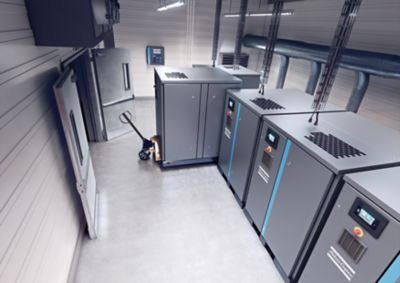What is a dual-speed compressor?
Until 2023, there were two types of rotary screw compressors: fixed-speed compressors and models equipped with a variable speed drive (VSD). This year, Atlas Copco introduced the dual-speed compressor. This article answers the question, what is a dual-speed compressor?
What is a dual-speed compressor?
Fixed-speed compressors are fairly basic machines that only run at full speed once you turn them on. The upside for operations that don’t want to or can’t invest in a VSD compressor is that their purchase price is relatively low. However, unless you require maximum air output all the time (which is hardly ever the case), it wastes a lot of energy. As a result, its operating costs are higher.
VSD compressors do the opposite. Their initial investment cost is higher but they are much more efficient because their motor speed adapts to the compressed air demand. And, because energy costs make up the bulk of a compressor’s total cost of ownership, they are cheaper to operate. From the very beginning, they can save their users lots of money.
Now, however, there is a third type: the dual-speed compressor. It's ideal for people who want much more than a fixed-speed model can deliver but are not yet ready for a VSD. This brand-new category of compressor is superior to fixed-speed models while also featuring some of the benefits of a VSD.
What is a dual-speed compressor?
As the name indicates, dual-speed compressors have two speeds. Similar to fixed-speed models, one of those speeds is “all out” when users need a maximum output of compressed air. But it also has a minimum speed for when the compressor goes into unload when air demand is lower.
It is the second speed that makes all the difference, as it generates energy savings in different ways.
Transient losses and unload losses
One of the downsides of fixed-speed compressors is that they experience significant transient losses. This is the energy loss that happens as the compressor cycles between operational phases.
These transient losses are an issue from the moment the compressor starts. That’s because fixed-speed unit cannot start against a pressurized system. That means that when the compressor starts, it needs some time to build up the required pressure. During that time, it uses energy while not producing usable air yet.
When air demand lowers, a fixed-speed compressor goes into unload. This is where the motor runs at maximum speed without producing air. The energy losses incurred here are the so-called unload losses.
Transitioning to unload, the compressor must also vent the air still present in the air/oil separator. Otherwise, the fixed-speed compressor would be unable to start again later. You might know type of transient losses as blow-off losses.
These unload and transient losses quickly add up. Together, they can make up 40% of the energy use of a fixed-speed compressor. That is the case for even the most efficient fixed-speed models. That's because significant transient losses are inherent to fixed-speed technology. They simply cannot start with a system under pressure and can only run at 100% motor speed.
A dual-speed compressor reduces transient losses
A dual-speed compressor fixes these problems for the most part. It can start under pressure, which means that it requires less energy to start producing air. In addition, it experiences much lower blow-off losses because it doesn’t need to vent as drastically as a fixed-speed. Finally, a dual-speed compressor’s lower motor speed in unload reduces energy consumption.
Add it all up and a dual-speed compressor can deliver up to 20% energy savings compared to a fixed-speed.
Flexible pressure setting
Another key benefit of a dual-speed compressor is that you can select any pressure without compromising on air flow or FAD. In other words, it works optimally at any pressure setting. What is more, this possibly allows users to get a smaller-sized dual-speed than the fixed-speed alternative. This in turn can reduce investment and operational costs.
All of these advantages make a dual-speed compressor a superior alternative to traditional fixed-speed models.
This article set out to answer the question, what is a dual-speed compressor. If you still have questions about this new type of compressor, our experts are always happy to help.
Find out more about the
Find out more about the
Find out more about the
Find out more about the GA FLX, the first dual-speed rotary screw compressor. It is the perfect solution if you’re looking for compressor energy savings but are not ready yet for a Variable Speed Drive.

